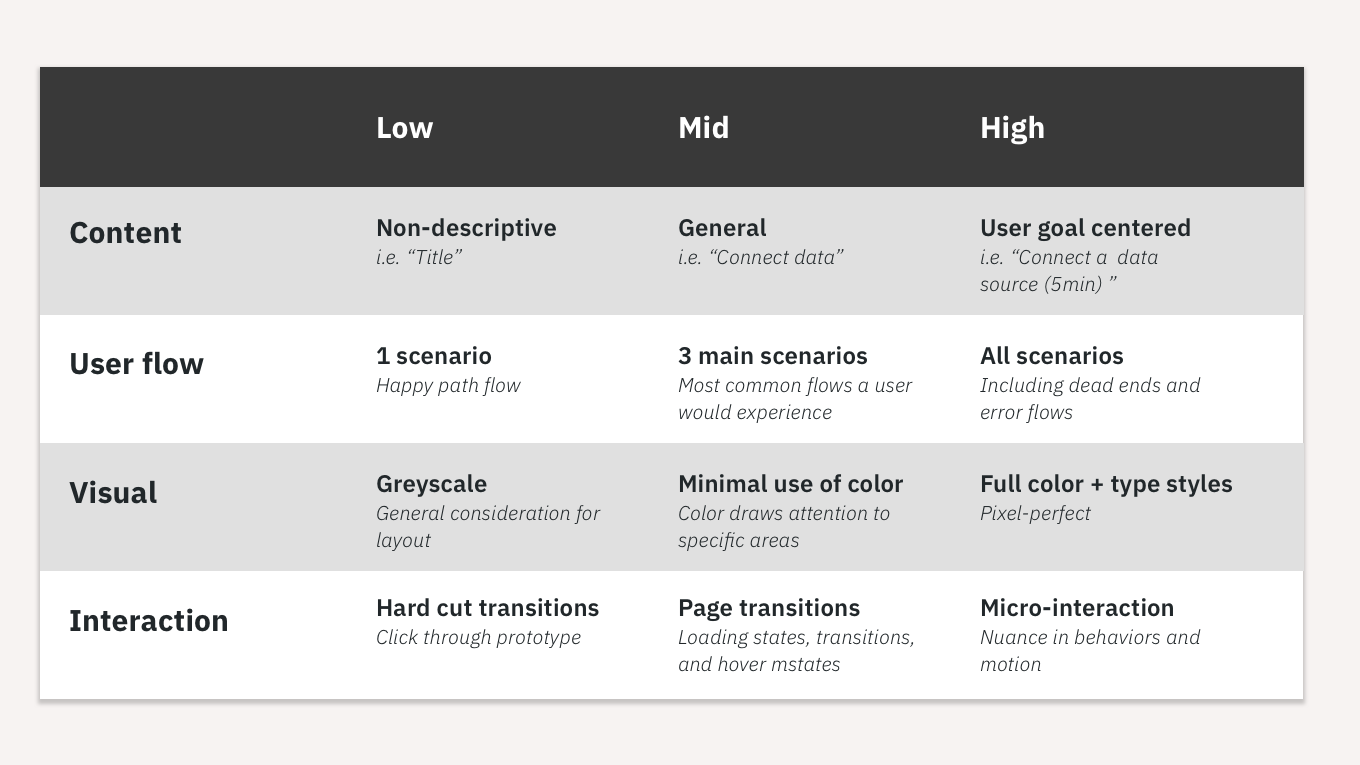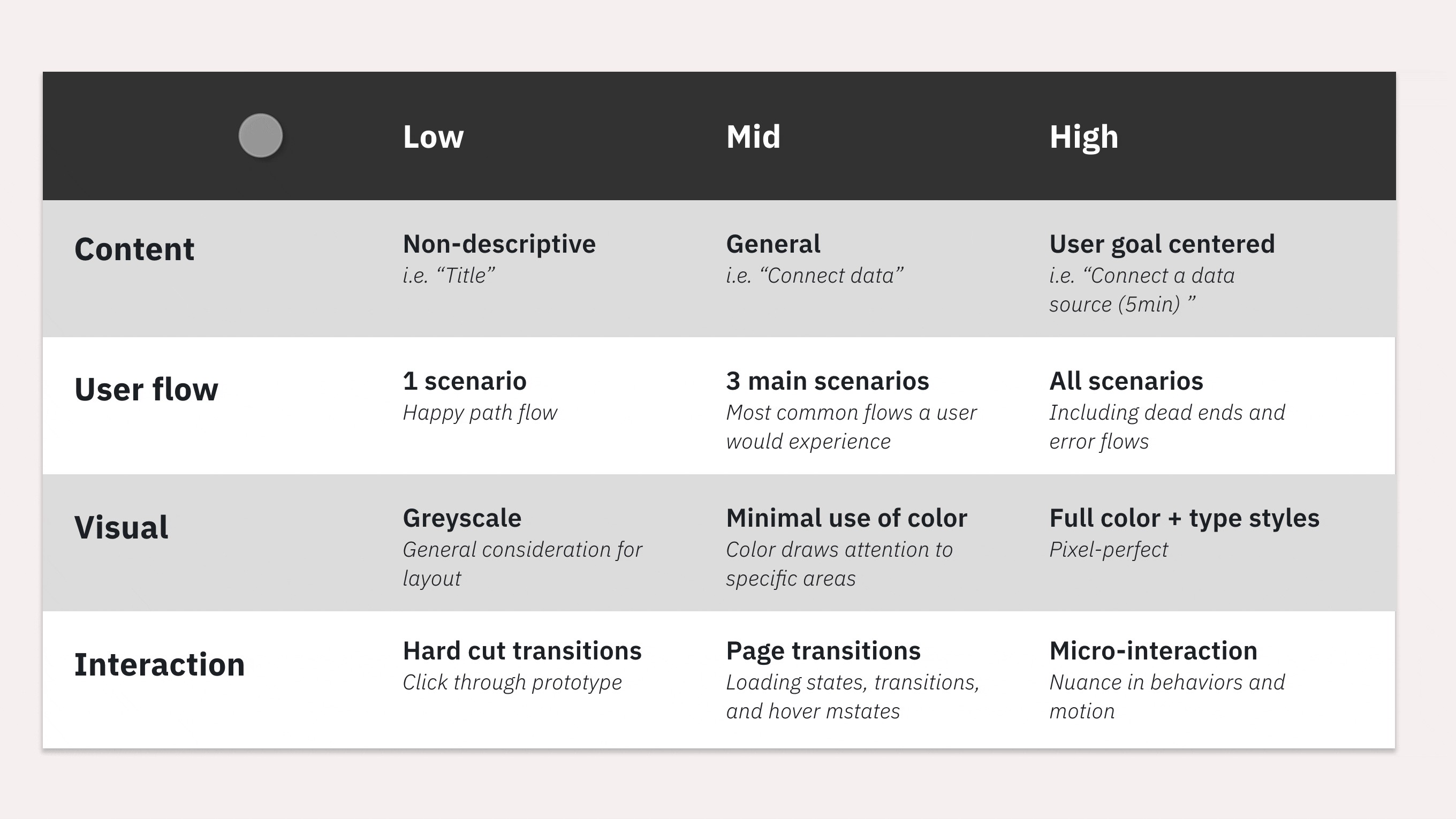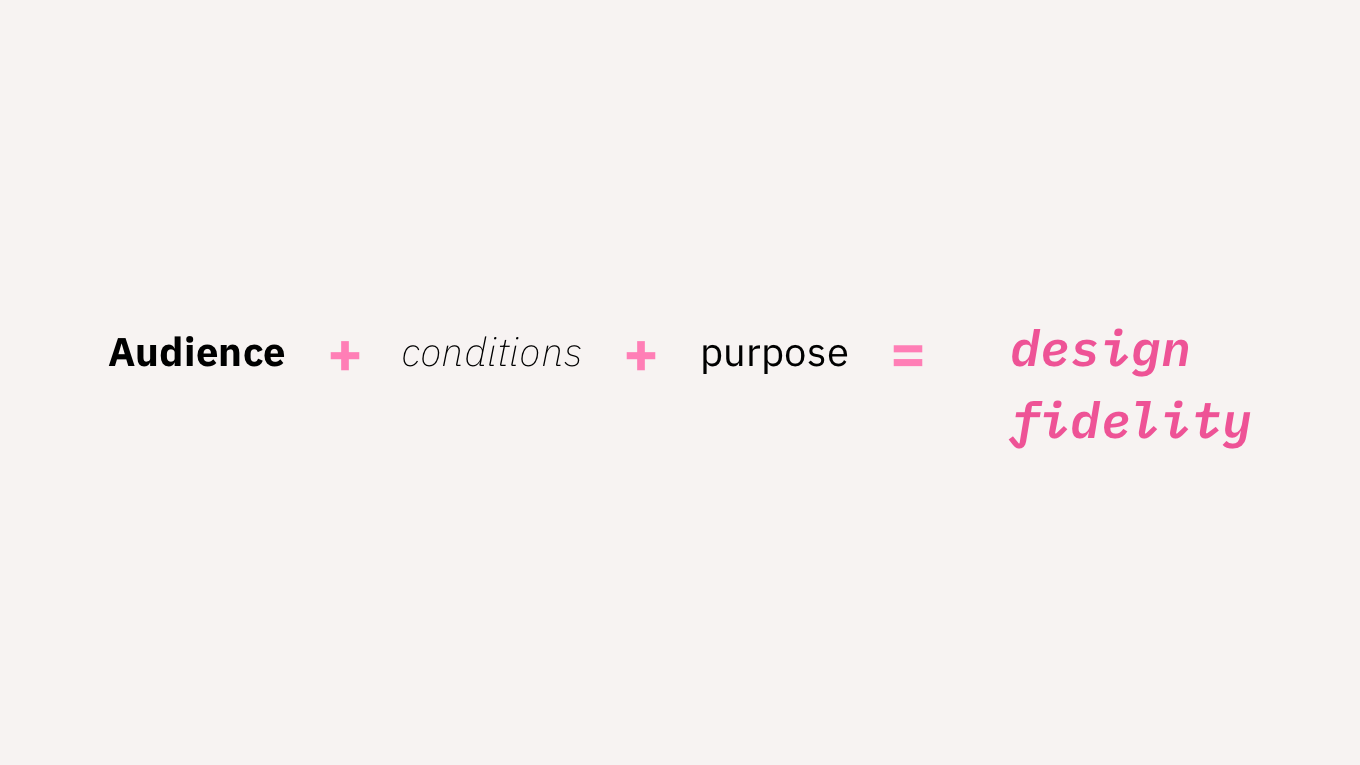信息保真度準則
As designers, our audience is more than just our users. We keep our user’s needs top of mind while designing for their jobs-to-be-done, but sometimes we need to illustrate the problem and articulate solutions to a broader audience: our cross-discipline team and stakeholders.
作為設計師,我們的受眾不僅僅是我們的用戶。 在為用戶要做的工作進行設計時,我們始終將用戶的需求放在首位,但是有時我們需要說明問題并向更廣泛的受眾(包括我們的跨學科團隊和利益相關者)表達解決方案。
To create the best experiences we can for our users, we need to minify the distractions in pixel-perfect designs and hone in on the optimization of end-to-end user flows.
為了為我們的用戶創造最佳體驗,我們需要減少像素完美設計中的干擾,并優化端到端用戶流程。
Usually, designers work through user experiences by assigning a fidelity to their designs. Design fidelity is the level of detail in any of the following four characteristics of an experience:
通常,設計師通過為設計分配保真度來體驗用戶體驗。 設計保真度是體驗的以下四個特征之一中的詳細程度:
Content: written information that sets the tone and informs intent
內容:定下基調并傳達意圖的書面信息
User flows: end-to-end experiences
用戶流:端到端體驗
Visual: fine-tuning colors, type styles, layouts
視覺:微調顏色,字體樣式,布局
Interaction: micro-interactions and motion timing
交互作用 :微交互作用和運動定時
Typically speaking, the lower the fidelity, the more abstract these characteristics are. The higher the fidelity, the more granular these characteristics become.
通常來講,保真度越低,這些特征越抽象。 保真度越高,這些特征就越細化。
設計保真度的范圍 (The spectrum of design fidelity)
As designers, we usually speak about our designs by assigning a fidelity of low, mid, or high.
作為設計師,我們通常通過分配低,中或高保真度來談論我們的設計。
Low fidelityLow fidelity focuses on design concepts, rather than pixel-perfect experiences. You spend less time perfecting the bezier curve of an interaction, and more time on the ideation of a concept. Low-fidelity can take form in sketches, thumbnail variations of a UI layout, or even basic Post-it note flows.
低保真低保真專注于設計概念,而不是像素完美的體驗。 您花費更少的時間來完善交互的貝塞爾曲線,而將更多的時間花費在概念的構思上。 低保真可以采用草圖,UI布局的縮略圖變體甚至基本的便利貼流程的形式。
Mid fidelityMid-fidelity begins to provide layout and experience context without the distraction of color, content, or interaction.
中保真度中保真度開始提供布局和體驗上下文,而不會分散顏色,內容或交互。
High fidelityHigh fidelity resembles how the product will look and feel when a user interacts with it. High fidelity is great to simulate a real experience during feedback sessions.
高保真度高保真度類似于用戶與產品進行交互時產品的外觀和感覺。 高保真非常適合在反饋會議期間模擬真實體驗。
This may be the standardized language we use today — but it ain’t a one-size-fits-all sitch, y’all.
這可能是我們今天使用的標準化語言,但它并不是萬能的。
混合搭配,然后再次混合搭配 (Mix and match, then mix and match again)
The trick to design fidelity is defining how you can eliminate distractions in your designs. If you’ve ever gone to a design review and said “Don’t worry about this piece right now[insert arbitrary design component here]. I haven’t designed it yet,” then you might be causing potential confusion for your audience to critique your work. Why put it there if it doesn’t tell the right story and drive the alignment you’re looking for?
設計保真度的技巧是定義如何消除設計中的干擾 。 如果您曾經去過設計審查并說“現在不用擔心這件事情,請在此處插入任意設計組件”。 我還沒有設計出來,”那么您可能會引起潛在的困惑,讓聽眾批評您的作品。 如果沒有告訴正確的故事并推動您要尋找的路線,為什么要放在那里?

When exploring new ideas, not all characteristics of the design need to be the same fidelity. In fact, each characteristic of design can be assigned their own level of fidelity.
探索新想法時,并非設計的所有特征都必須具有相同的保真度。 實際上,可以為設計的每個特征分配自己的保真度。

You can actually mix and match the fidelity of an experience using those four characteristics listed above: content, user flow, visual, interaction. The best part? There’s really no special combination. It’s all about the goal you are trying to accomplish.
實際上,您可以使用上面列出的四個特征來混合和匹配體驗的保真度: 內容,用戶流,視覺,交互。 最好的部分? 確實沒有特殊的組合。 這與您要實現的目標有關。

新公式 (A new formula)
Instead of thinking of your designs in terms of the low to high fidelity spectrum, think of your designs using this formula:
不用從低到高保真度頻譜來考慮您的設計,而是使用以下公式來考慮您的設計:

Audience + conditions + purpose = design fidelity
受眾+條件+目的=設計保真度
Let’s break it down.
讓我們分解一下。
Audience: Understand who you are showing your designs to and what they care about. Here are some questions to consider:
受眾 :了解向誰展示設計以及他們關心什么。 以下是一些要考慮的問題:
- Is your legal team concerned with the terminology used in-product? Spend your energy on making the content spot on. 您的法律團隊是否關心產品中使用的術語? 將精力投入到內容上。
- Is your developer wanting to understand what happens if the system fails? Get your end-to-end flows in a functional state. 您的開發人員是否想了解如果系統發生故障會發生什么? 使您的端到端流處于功能狀態。
- Does your product manager only care about the feature that is shipping at the end of the quarter? Greyscale the screen and get the feature up to a high-fidelity design. 您的產品經理是否只關心本季度末交付的功能? 對屏幕進行灰度處理,并使其功能達到高保真設計。
- Are you using this design for user testing? Make it look and feel as real as possible. 您是否正在使用此設計進行用戶測試? 使其外觀和感覺盡可能真實。
Conditions: Due to co-located teams, consider the conditions in which your work will be presented.
條件 :由于團隊位于同一地點,請考慮將要展示您的工作的條件。
- Is it over Webex or Zoom? Focus on low fidelity interaction because the video call will cause a lag anyway. There’s no need in wasting time perfecting the nuance of a bezier curve when Webex/Zoom/Google Hangouts says NOPE. 是通過Webex還是Zoom? 專注于低保真度互動,因為無論如何視頻通話都會引起延遲。 Webex / Zoom / Google Hangouts表示NOPE時,無需浪費時間完善貝塞爾曲線的細微差別。
- Are you driving the meeting or is a stakeholder driving the meeting? Know what artifacts they need to set the whole team up for success. 您是在主持會議還是利益相關者在主持會議? 知道他們需要什么產品來使整個團隊成功。
- How much time do you have to present your work? Optimize your story by hashing out the most important part of the user experience. 您需要多少時間來展示您的作品? 通過散列用戶體驗中最重要的部分來優化您的故事。
Purpose: It’s important to show the intent behind each characteristic of your design to draw focus.
目的 :重要的是要顯示設計的每個特征背后的意圖以吸引人們的注意力。
- What kind of feedback are you looking for? Go into a presentation knowing exactly what questions you want to have answered. 您在尋找什么樣的反饋? 進入演示文稿,確切地知道您想回答什么問題。
- Only have a few days left in the sprint? Be upfront about how much time you have left to deliver. 沖刺只剩下幾天了? 提前預留剩余的時間。
- Who are your users and what are their needs? Inform your audience of the user’s intent while taking your audience through the experience you’ve designed. 您的用戶是誰,他們的需求是什么? 在引導您的受眾通過您設計的體驗的同時,向其受眾傳達用戶的意圖。

TL; DR (TL;DR)
Approaching your designs with this formula can enable you to target a specific aspect of the user experience that needs the most attention from your stakeholders. Focusing on the audience, conditions and purpose can help assist you to optimizing your design process. Remember these key takeaways:
使用此公式來進行設計可以使您針對用戶體驗的特定方面,這需要利益相關者給予最大的關注。 關注觀眾,條件和目的可以幫助您優化設計過程。 請記住以下關鍵要點:
- There are four characteristics to design: content, user flow, visual, and interaction. Within these four characteristics, designers can assign a fidelity of low, mid, or high. 設計有四個特征:內容,用戶流,視覺和交互。 在這四個特征中,設計人員可以指定低,中或高保真度。
- When iterating through experiences, try mixing and matching the fidelity of each characteristic to minify distractions. 反復體驗時,請嘗試混合并匹配每個特征的保真度,以減少干擾。
- Understanding your audience and what they care about will help you focus your energy on what matters in your design. 了解您的受眾及其關注的內容將有助于您將精力集中在設計中的重要方面。
- Drive the conversation by knowing the purpose of your design and exactly what kind of feedback you’re looking for. 通過了解設計的目的以及正在尋找的反饋類型來推動對話。

翻譯自: https://uxdesign.cc/a-new-non-scientific-formula-to-design-fidelity-4a691132d684
信息保真度準則
本文來自互聯網用戶投稿,該文觀點僅代表作者本人,不代表本站立場。本站僅提供信息存儲空間服務,不擁有所有權,不承擔相關法律責任。 如若轉載,請注明出處:http://www.pswp.cn/news/274159.shtml 繁體地址,請注明出處:http://hk.pswp.cn/news/274159.shtml 英文地址,請注明出處:http://en.pswp.cn/news/274159.shtml
如若內容造成侵權/違法違規/事實不符,請聯系多彩編程網進行投訴反饋email:809451989@qq.com,一經查實,立即刪除!)











—從圖片中獲得配色靈感)






